

The Classic British Isles Buses Website
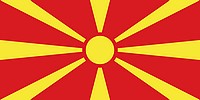 Transport in Macedonia in 2019: page 2 - cars and trucks (by Dick Gilbert)
Transport in Macedonia in 2019: page 2 - cars and trucks (by Dick Gilbert)
Last updated 28 August 2024
Email Events diary Past events list Classified adverts Classic U.K. Buses Classic Irish Buses Classic Manx Buses
| Buses | Cars and trucks |
In 1970 I drove up from Greece, through Yugoslavia close to the Albanian border, to the Adriatic in what is now Montenegro and all the way up the coast through Dubrovnik and Split to Italy (the full story about that trip which stetched from England to Iran and back is on my webpage here). Today that journey from Greece to Italy would traverse five separate countries, and on this page we look at just one of them - Macedonia, now called North Macedonia to differentiate it from the area of Greece with the same name.
North Macedonia is a landlocked country but has some fabulous lakes which serve as home to its coastal resorts. In September 2019 I stayed at Ohrid on the northern edge of Lake Ohrid. Here are some of the cars and trucks I saw on my travels. Marin Pazanin from Croatia has helped out with some identification.

This beauty, seen behind a petrol station in Kichevo, is a MAZ, built in Belarus by the Minsk Automobile Plant back in Soviet times. MAZ started production in 1949 and is still going today, operating as a joint venture with MAN of Germany (MAZ-MAN).
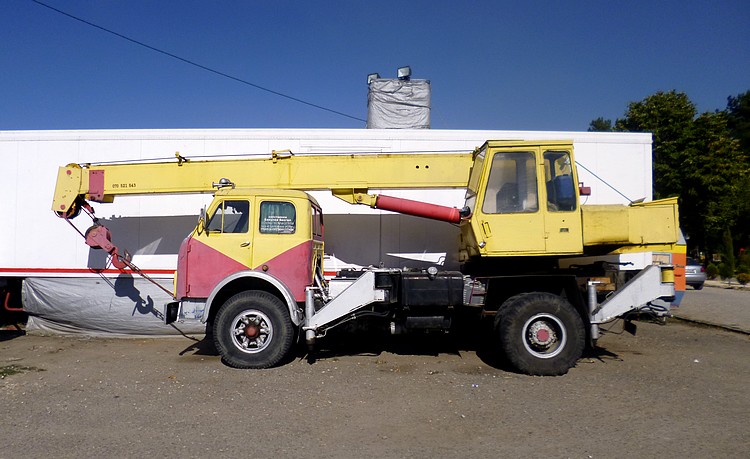
The basic design was the MAZ-500, made from 1965. An improved MAZ-500A version was introduced in 1970 and a further upgrade - the MAZ-5335 - was introduced in 1977 and continued to be built until 1990. I believe this is a MAZ-5335. It is registered BT.247CL, where BT represents the town of Bitola. The engine is an 11.2 litre V6 diesel.

This van, seen in Ohrid, is a long way from home. It's a Dongfeng EQ5021 minivan from China and has a 1.3 litre engine, and its registration plate has fallen off.

Seen in the back streets of Ohrid this is another one of those delightful little TAM trucks that I had previously mentioned on my Croatian page. This particular example (registered OH.892BK) is an 80T50. 80 refers to the horse power, T means Truck and 50 represents 5 tons capacity. I'm told that the truck is known locally as the Tamic (little TAM).

Here's another little TAM showing off how tough they are, as it's hauling a road roller through Bitola. TAM stands for Tovarna Avtomobilov Maribor (Maribor Automobile Factory), a commercial vehicle producer based in the city of Maribor in Slovenia. Created in 1946 from a wartime aircraft parts factory, it became Yugoslavia's largest truck manufacturer but eventually closed down in 1996.
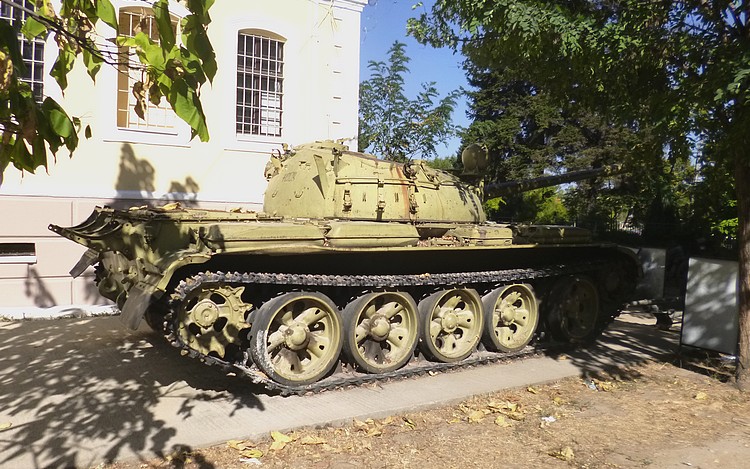
Outside the excellent museum in Bitola (located in a former army barracks) were a few military items on display. This is the famous Russian T-55 tank and it seemed a bit unpopular. Not only was there graffiti on the tank itself but also the information signboard had been torn and defaced. No doubt the population of Macedonia is very uneasy about a Russian tank rolling into their country - Tito taught them that back in Yugoslav days!
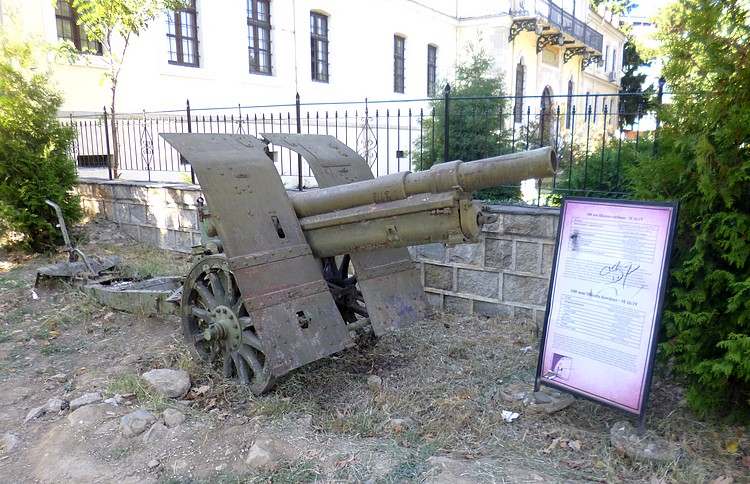
Also outside the Bitola Museum was this 100mm Skoda Howitzer M16/19. 16/19 means it was built by Skoda in Czechoslovakia between 1916 and 1919. It had a 6 mile range and was used by mountain howitzer battalions.
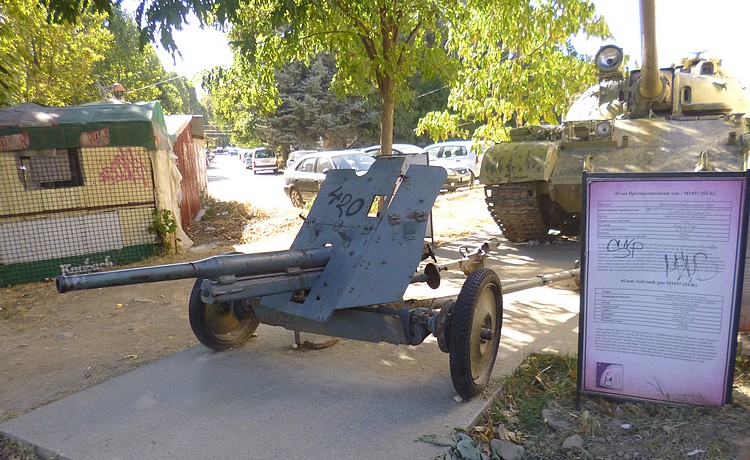
This is a 45mm lightweight quick-firing anti-tank gun M1937 (Soviet factory designation 53-K) with a maximum range of 4.4km. It was derived from a German design and built by the Soviet Union from 1937 (hence the M1937) to 1943, subsequently being used by the Yugoslav Peoples' Army. 37,000 of them were built.
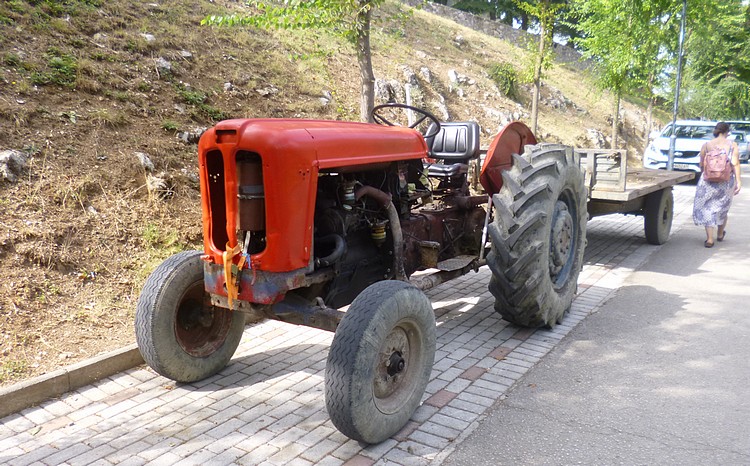
From swords into ploughshares! This tractor was working at the Saint Naum Monastery on the banks of Lake Ohrid. No obvious clues to who built it, so I had to investigate further...

...and here's the answer. This plate beside the steering wheel explains that it was built by IMT (Industrija Masina i Traktora) in Belgrade, now the capital of Serbia. IMT was founded in 1947 and sold to an Indian enterprise in 2018. This turns out to be an IMT 558. Marin Pazaanin from Croatia told me that IMT 558 production started in the 1970s and it had an 80 h. p. engine. Apparently IMT's tractors were originally built under licence from Massey Ferguson with Perkins engines.
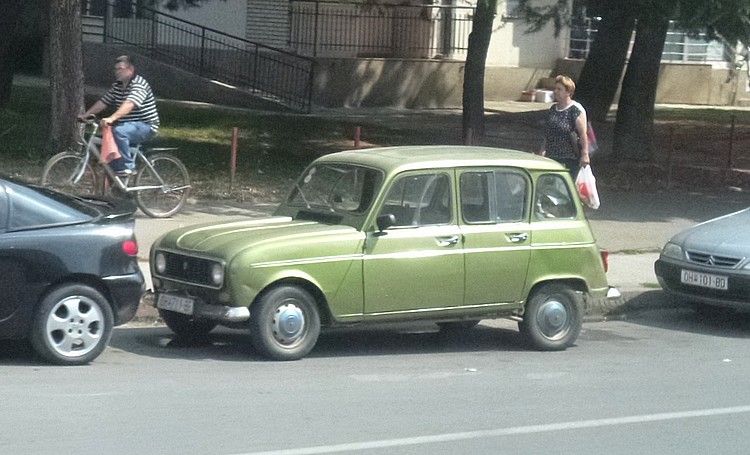
Unlike Albania, where nobody was allowed a car until the 1990s in case they used it to escape from the repressive Communist regime there, North Macedonia has a history of cars, so older vehicles can still be seen everywhere. The Renault 4 shown here was very common in the former Yugoslavia as they were built in Slovenia from 1969 to 1992. We also frequently saw Renault 5s and old Mercedes cars and trucks.
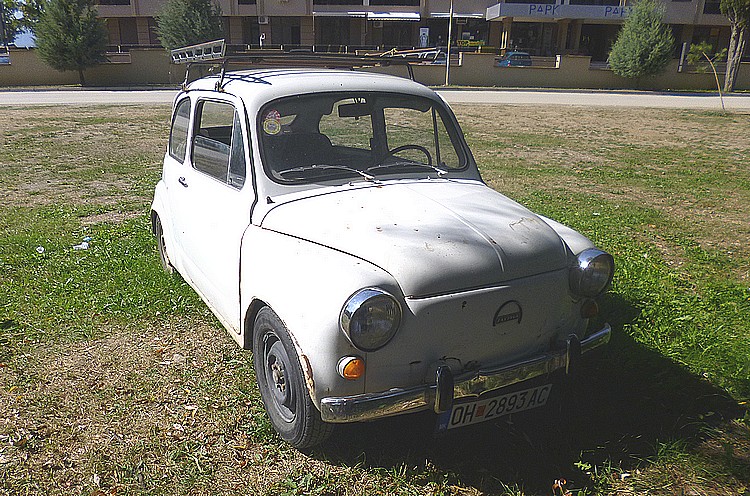
It looks like a Fiat 500 but it's not. It's a Zastava 750 Fico which came about as the result of a co-operation between the two companies and is a licence-built version of the Fiat 600, although slightly longer and with a 767 c. c. engine. It was produced for an amazing 30 years (from 1955 to 1985) and over 900,000 were built.
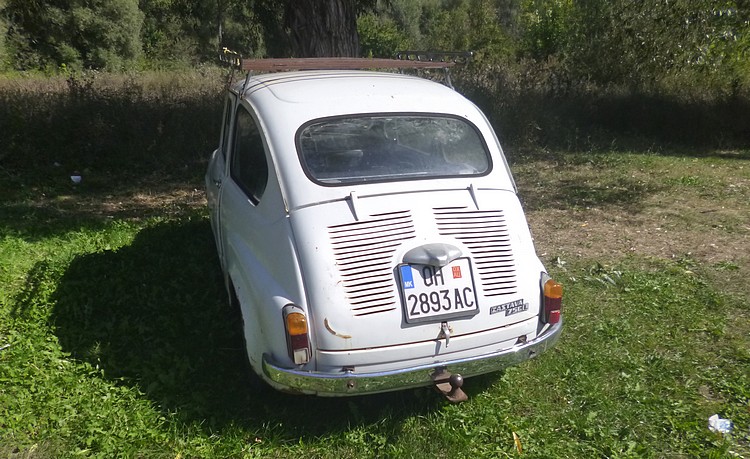
This particular example (registered OH.2893AC) seen near Ohrid is a Zastava 750L (the De Luxe version) and probably dates from the early 1980s. The Zastava factory was in Kragujevac, Serbia and we also saw some light trucks that had been made there. Although Ficos were immensely popular in their day because they were cheap to buy and run, they are now becoming rare.
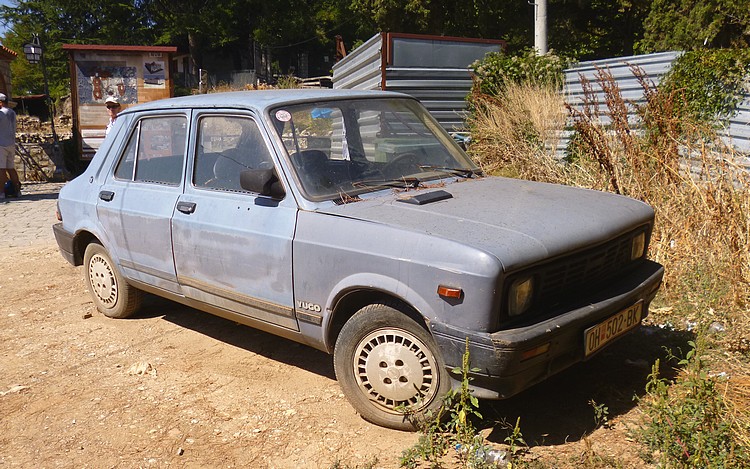
The Yugo 101 Skala (also known as the Zastava Skala) was basically a licence-built version of the Fiat 128, introduced in 1971. 1.2 million Skalas had been built by the time production ended in 2008! They were produced by Zastava Automobil in Serbia. This one was spotted near Ohrid, but there were many still around.

This example is a Yugo Skala 55C (55 = 55 horse power) with 5 doors, an 1100cc engine with automatic choke and front-wheel drive. The 55C was built from 1994 until the end of production, although I believe the Yugo-badged version (like this) was discontinued in 2003, after which they were all badged as Zastava.

Here's a Yugo Tempo, the final model in a family which was known until the mid 1990s as the Zastava Koral. It was developed from the Fiat 127, using a Fiat 900cc chain-driven engine and had a reputation for being tough and reliable. This is a pre-1995 model as it has a two-piece door window.

This upgraded Yugo Tempo 1.1, seen near the Saint Naum Monastery, is a later model with a one-piece door window, produced from 1995 to 2005. The car has front-wheel drive, five gears and three doors. They were built from 1977 to 2008 and nearly 800,000 were produced in various versions. They are commonly just called the Yugo.
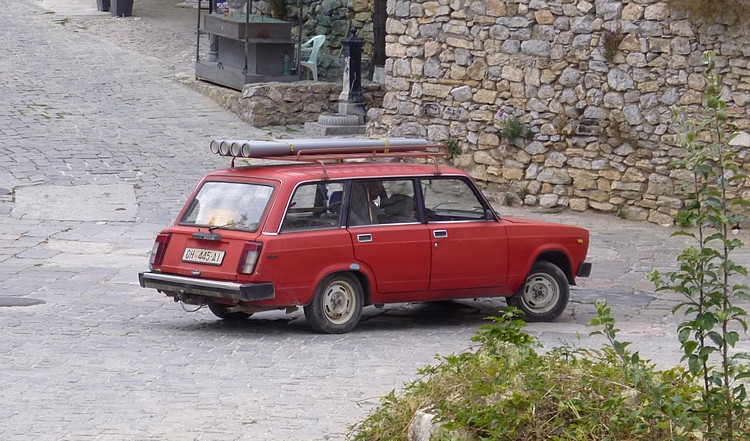
I've covered the range of Lada cars in detail on my Uzbekistan pages but here are a couple anyway. This is the Lada Riva built by AutoVAZ in Russia. Derived from the Fiat 124 it is the third best-selling car in history (the others being the Model T Ford and the Volkswagen Beetle). This is the 1500 c.c. estate, seen in Ohrid. Every time I see a Lada Riva there's always something piled on top of it!
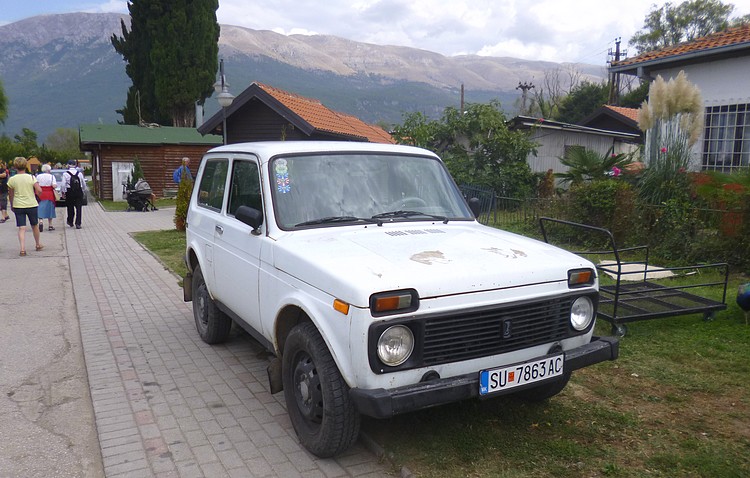
And this is a 4x4 Lada Niva VAZ-2121, seen near St Naum. They have been in continuous production in Russia since 1977 and you can still buy one in the U.K. today under the name Cossack. The 1600cc engine is noisy and vibrates a lot.

Here is a more modern Lada - the Lada 112, this example being the 1.5 GLI 16-valve model. Developed jointly in 1987 by AutoVAZ and Porsche as the Lada 110, the upgraded Lada 112 appeared in 1999 and is very popular in Russia.

Finally here's a Skoda Favorit LX 5-door hatchback. This was Skoda's first transverse front-engined front-wheel drive car, launched in what was then Czechoslovakia as the type 781 Favorit in 1987. The 1.3 engine has been described as noisy but willing. Production ceased after only eight years in 1995 (although nearly 800,000 had been built during that time) when it was replaced by the Skoda Felicia. It was the last of the home-grown Skodas as Volkswagen took over the entire firm in 1994 and everything then changed.
Email Events diary Past events list Classified adverts Classic U.K. Buses Classic Irish Buses Classic Manx Buses